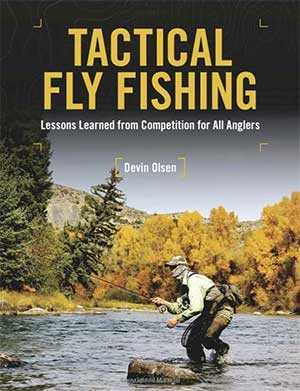How to Prevent Trout From Seeing You
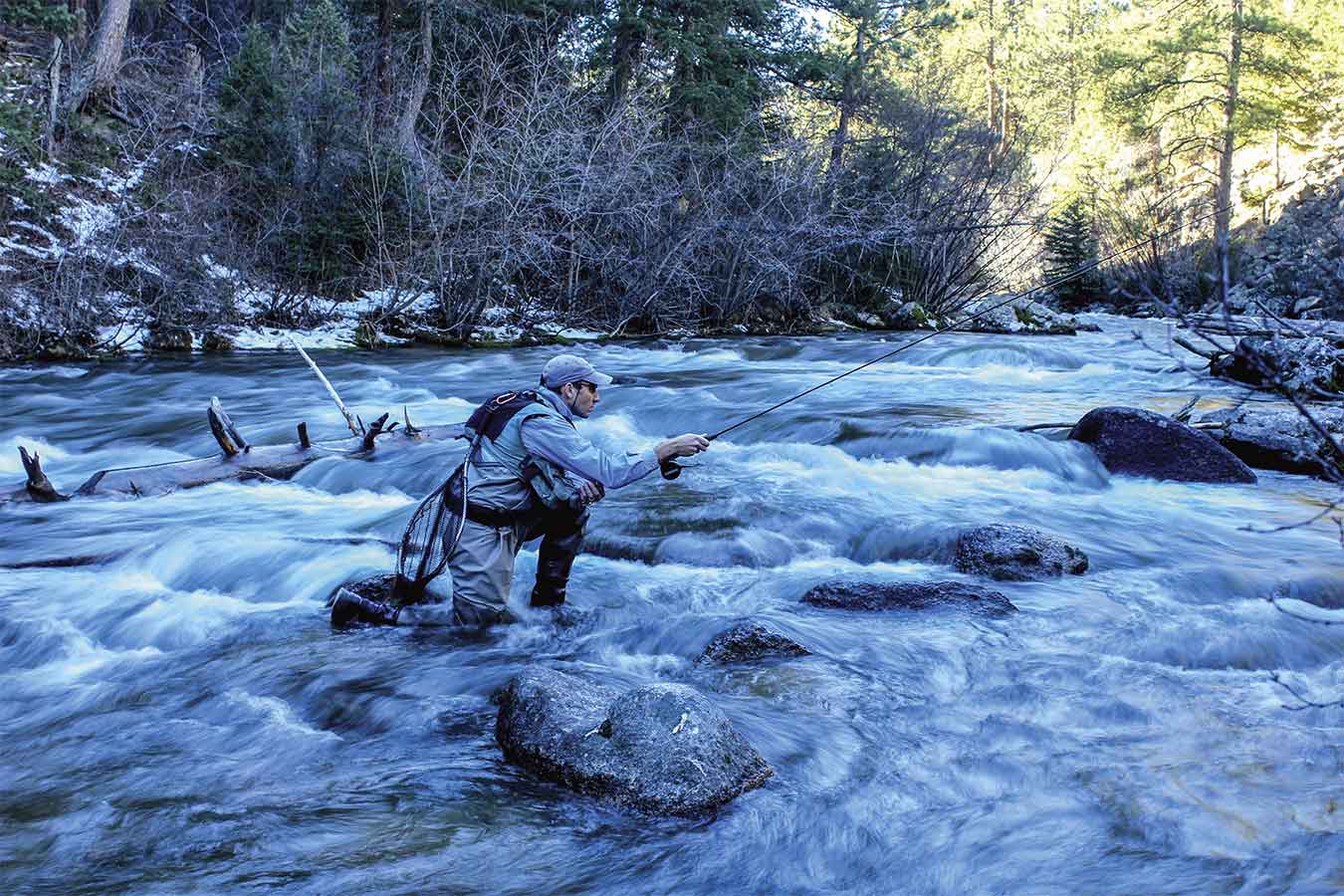
Though it may not look like good holding water, the area Antonio Rodrigues is fishing produced several fish in midwinter. By kneeling, he kept his profile low and his head and shoulders below the cone of vision of the trout he was targeting. If you can get past the extra effort and the odd looks from fellow anglers, kneeling will produce extra opportunities to catch unsuspecting trout when the water is clear and the fish are spooky.
How do you avoid alerting fish to your presence? Here are five strategies I use to help prevent fish from seeing me and perceiving me as a threat.
Fish a Longer Rod
One way to avoid showing yourself to fish in clear water is to fish from a greater distance. A lot of the nymph fishing I do is based on Euro-nymphing methods. These techniques are inherently limited in their effective range. Many anglers start off Euro-nymphing with a 10-foot rod. However, one of the ways to increase your range is to fish a longer rod. My friend and former Fly Fishing Team USA mate Charlie Card spends much of his time fishing on his home water, Utah’s Green River. This is a techy tailwater river often referred to as “The Aquarium” because its clarity is unsurpassed, and trout can be spotted everywhere, including at the bottom of pools more than 20 feet deep. A while back, I asked Charlie what strategies he uses to adapt to fishing the Green when Euro-nymphing. One of his simplest is that he only Euro-nymphs with rods 11 feet and longer at this river. With the longer rod, he is able to increase his successful radius of presentation; sometimes only a foot or two extra is needed to make the difference between spooking a fish and catching it.
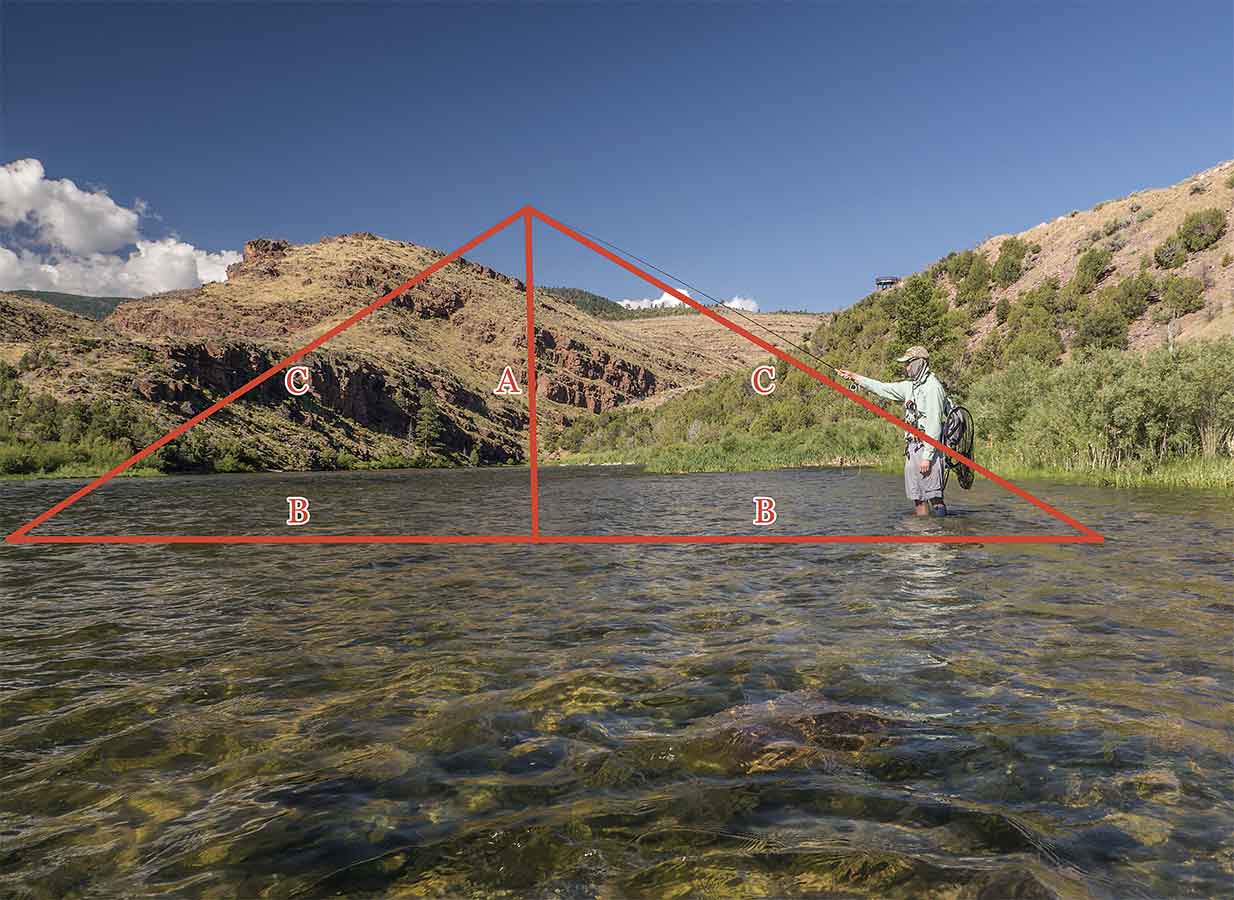
When Euro-nymphing, your rod loosely forms the hypotenuse of adjacent right triangles. With a little trigonometry it’s possible to calculate the difference in reach between rods of different lengths. In short, an extra foot of rod leads to more than an extra foot of reach. When fishing large rivers or clear pressured rivers with spooky fish, a longer rod can mean the difference between catching fish and coming up short.
Use a Fishing Method Tailored to Distance Presentations
The other strategy for fishing farther away is choosing the proper technique and rig for the situation. In clear water, the distances required to avoid spooking fish can be significant if the water is smooth and the view between air and water is not obstructed by broken surface currents. In these situations, I often choose to forgo Euro-nymphing in favor of a longer-distance strategy.
Let me provide an example. In the 2013 World Fly Fishing Championship in Norway, we fished the large, low-gradient Vefsna River. The weather turned warm and dry for several weeks leading up to the championship, and the river dropped and became very clear. The densities of fish were low in the river, and most sessions were won with less than 10 fish. When I arrived at the river during the championship, I found that 90 percent of my beat was a smooth, medium-velocity glide between 2 and 5 feet deep. While I could not spot fish, I could see the bottom easily, and knew the fish would see me.
Most of the competitors from other countries chose to fish wet flies swung on floating and clear intermediate lines, which worked well. However, I chose to rely on my suspension/strike-indicator nymphing background, and rigged a rod with a dry and tungsten nymph dropper to use the same approach, while staying within the FIPS-Mouche rules, which don’t allow floating devices on the leader other than flies. The dry fly was a large Chubby Chernobyl with extra yarn I added in the wing to increase the buoyancy and hold up heavy nymphs. I spent 90 percent of my session fishing this rig with a combination of dead drifts and twitches to move the dry fly. The grayling and brown trout fell hard for the duo, and I landed 16 fish for the session win, which was the highest number landed during any session of the championship. If I had stuck with the usual short-range Euro-nymphing approach, it’s possible I would have landed a few fish, but I doubt I would have been nearly as successful.
Use Naturally Occurring Obstructions to Shield You from the Fish
An often-overlooked way to minimize your chances of spooking fish is to use obstructions to block a trout’s view of your body or to blend into your surroundings. One of my favorite examples of this strategy comes from Gary Lafontaine. In his book Fly Fishing the Mountain Lakes, Gary shared a story about how he caught a wise old brown trout from a friend’s pond. In his first few encounters, Gary noticed that the fish would cruise its established path until swerving out into the pond after noticing Gary fishing from the bank. Gary placed an artificial tree on the bank near where the fish had established its territory and allowed the brown trout to become accustomed to it. On a subsequent trip, he used the tree to hide behind. As a result, he avoided signaling himself as a threat and easily caught the trout.
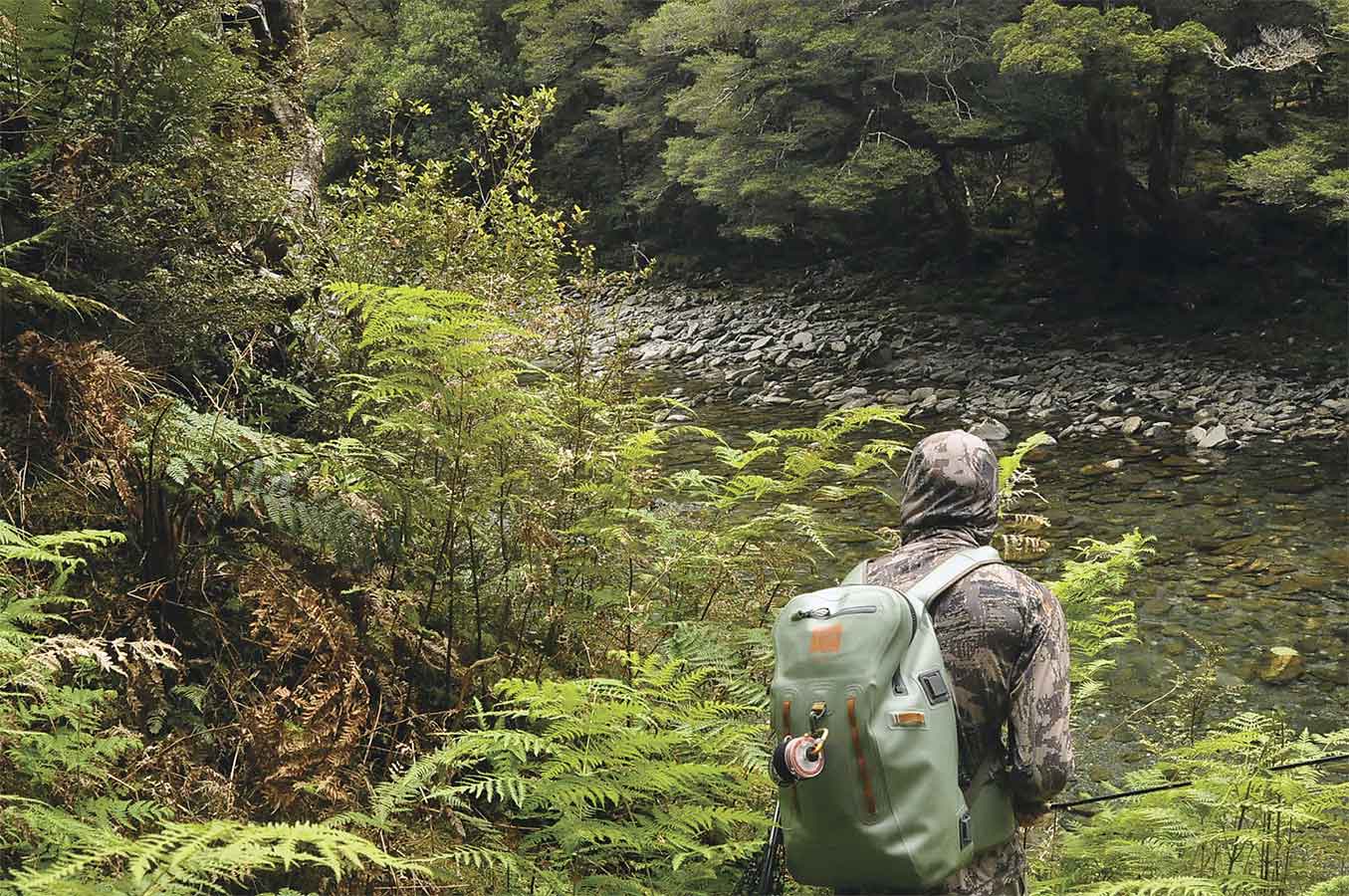
Anglers in New Zealand are known for wearing camouflage to hide their presence when stalking trout. Whether you sport full camo or not, avoid wearing bright colors, especially on your head and neck, and you will be able to approach more trout without spooking them. (PHOTO BY CONNOR MURPHY)
This story illustrates a strategy that few anglers use on the river. The fact is, there can be lots of types of obstructions to use while you’re on the river. The obvious ones are physical objects like rocks and trees. When placed between yourself and the fish, these objects can break up your outline just like the artificial tree did for Gary Lafontaine. If I’m fishing pocketwater, I will kneel on, lean on, or crouch behind available boulders that will help to break my silhouette and allow me to get closer to my target lie, or fish. I also look for dead trees hanging out over the river that I can use the same way.
The current itself is often the best and easiest veil to hide behind. When the surface of the river is broken enough to hide the riverbed, I place this current in between myself and my target lie, just like it was a tree or rock. If you force the fish to look through broken current, either they won’t be able to see you, or their view will be broken enough that they won’t consider you a threat. A common example of this strategy is fishing from a wading position in the river to the lies on the far bank. When there are waves and broken water running between you and your target lie, they will hide your outline and allow you to cut the distance between you and the trout you’re after. When you can fish closer to your target, you can reduce the slack in your presentation, improve your strike detection and deadness of your drift, and quicken your hook-set reaction time.
If you can’t find turbulent water or a physical object to put in between yourself and the fish, another strategy to try is blending into your surroundings. If you have ever seen photos of anglers from New Zealand, or have taken a trip there, you will likely notice a lot of anglers wearing camouflage. While this may seem overzealous to some, they deal with the difficulties of spooky trout in clear water on a daily basis, and use any strategy they can to reduce the trout’s perception of them as a threat. You may not need to dress fully like an archery hunter to avoid spooking fish on your local river, but I’m convinced it can pay dividends to dress in drab colors that don’t stand out drastically from the vegetation in the riparian zone. This is particularly important when it comes to hats or shirts, since the parts of your body fish are most likely to see first are your head, shoulders, neck, and outstretched arms.
Lower Your Elevation and Profile
Keep repeating the mantra, “If I can see the bottom or the fish, they can see me.” As you wade into position to fish a lie, think about your position and your height. If where you plan to wade puts your head high above the water, fish are more likely to see you. If you can wade into a depression between rocks or step off a gravel bar or shelf into deeper water, you will diminish your presence to the fish.
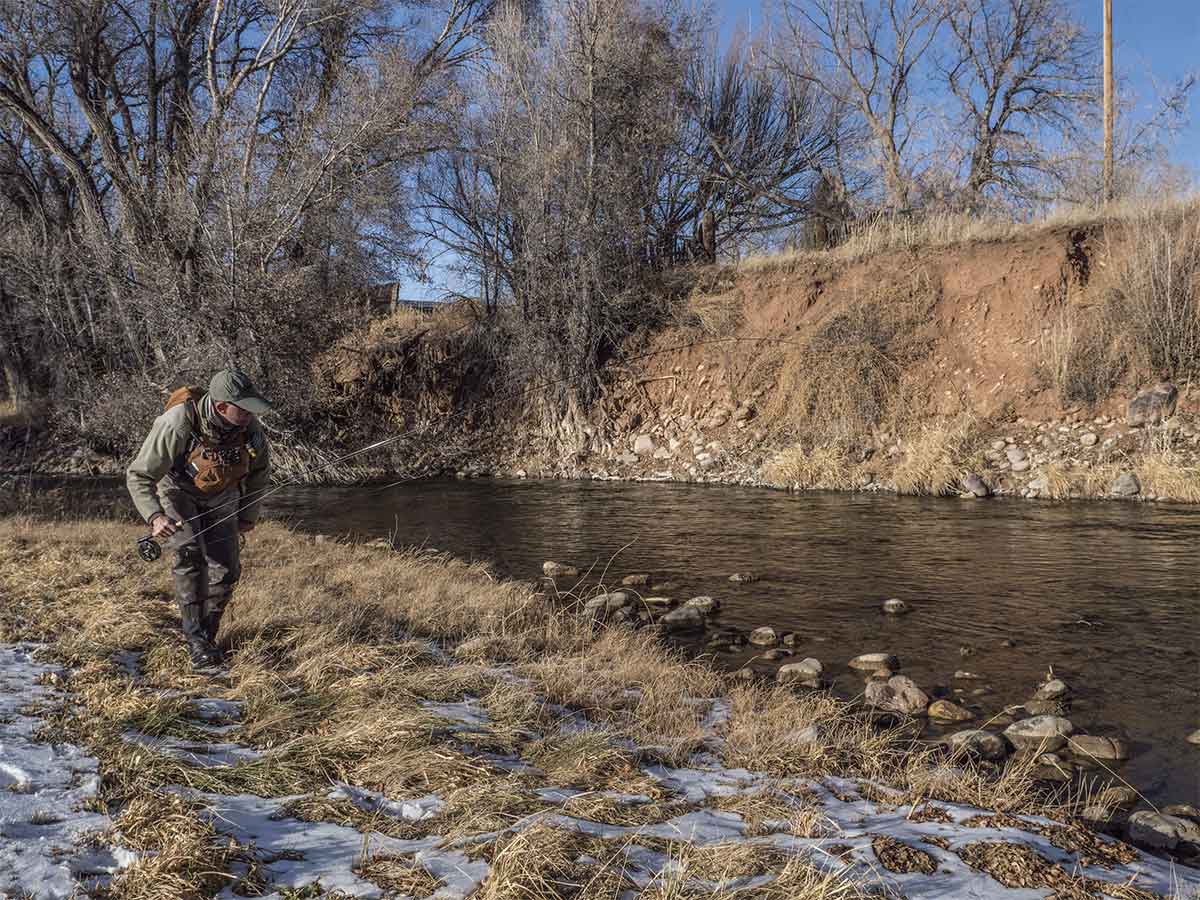
Keeping your shadow off the water you plan to fish is critical to avoid alerting trout to your presence. In this photo, Lance Egan gets into fishing position by crouching. The low afternoon sun angle on this December day cast long shadows; by keeping his shadow off the water, Lance avoided spooking the fish he was about to catch.
This is a common problem when fishing from an inside bend. These locations are deposition zones for the river, and flooding flows often deposit gravel or cobble that forms a steep slope. A single step toward the center of the river may lower your profile 6 to 12 inches in these types of locations. Even though stepping into the river will put you closer to your intended lie, the reduced height may decrease the angle between you and the water’s surface sufficiently for you to get under the cone of vision of the trout you are pursuing. Be cognizant of your casts as well. Many of the best dry-fly anglers I know make sidearm casts to keep their line close to the water and out of view of the trout.
In addition, a lot of anglers overlook the position of their shadow as they approach the river. There is no better way to send trout scurrying for cover quickly than a shadow cast across their holding lie. If you have ever watched trout holding in a pool as a bird of prey flies over and casts a shadow on the water, you have likely seen the instant panic that ensues. As you approach the water, pay close attention to where your shadow extends, especially when the sun is at low angles during the day and your shadow is longer. Crouch to get into position if necessary and you will find more fish still willing to eat when you make your first cast.
If the water is less than knee-deep or if I’m fishing from the bank, I will often fish from my knees. During the session on the Pliva River in Bosnia I described earlier, the only way I could approach the fish I spotted was from dry land on the bank they were holding by. Heavy water in the middle of the channel prevented an across-theriver approach. I spent two and a half of my three hours in that session fishing from my knees on the bank. I firmly believe I would not have caught any fish had I been standing over them.
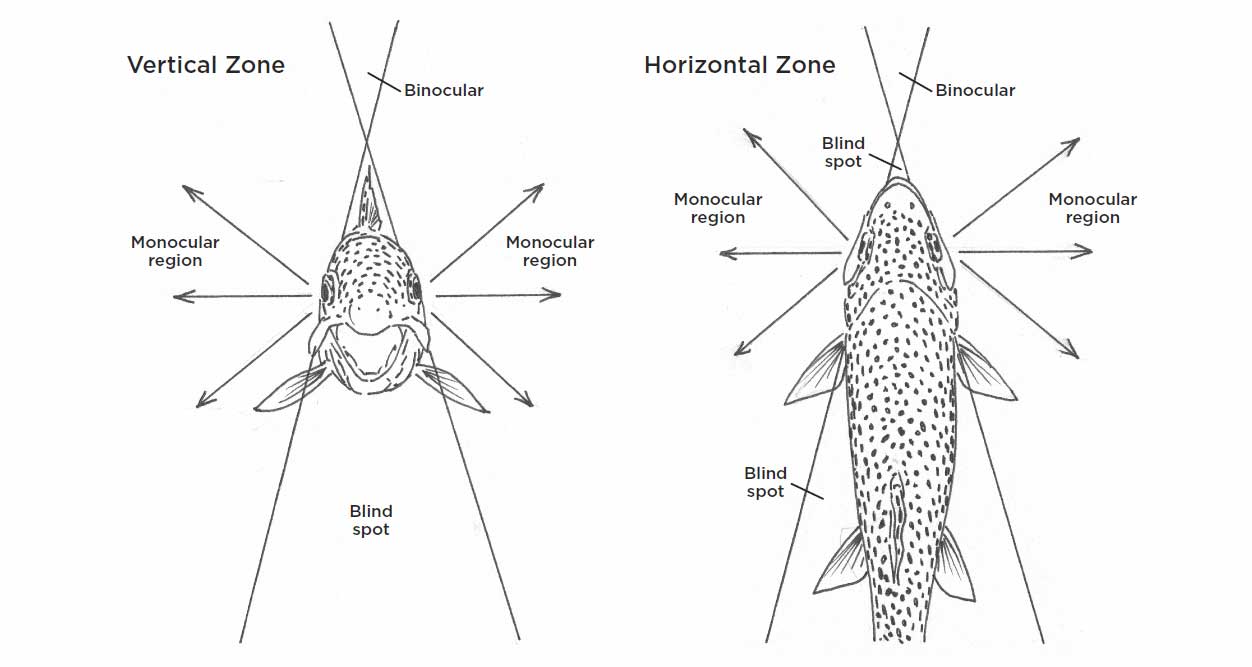
The location of its eyes allows a trout to see much of the world around it in binocular or monocular vision. However, there is one blind spot behind its head where you can approach it and stay out of sight.
A similar strategy paid dividends during the 2011 National Fly Fishing Championship in North Carolina. I drew a beat on the Nantahala River in my final session that had produced poor results for other anglers in the previous four sessions. When I scouted the beat, there was a long section (80–100 yards) of shallow pocketwater at the bottom, which was difficult to approach in the low, clear flows. However, the temperatures were prime, and I thought there would be fish that hadn’t been bothered by other competitors in this less-prime-looking water.
I spent the first two hours of my session on my knees slithering from rock to rock. Trout came easily in the turbulent yet shallow water. They were much harder to fool in the obvious pools and deep pockets above, which earlier competitors had likely targeted heavily. Though I did not win the session, I was able to get a third place on a tough beat, which was good enough to secure a silver individual medal for the championship. If I had taken the road heavily traveled in the deep pools and obvious pockets, my finish would have been much worse. Instead, a low-profile approach, to water that was prime for the river conditions, produced results.
Approach Fish from Downstream to Avoid Being Seen
The anatomical position of a trout’s eyes allows it a cone of monocular vision on the sides and binocular vision in the front, but it has a blind spot directly downstream. If you stay in that blind spot, the trout won’t be able to see you until your proximity becomes too close.
My teammate Pat Weiss is a master of fishing upstream to trout. Reading back through my journals of the competitions we’ve fished together over the past few years, my comments from our practice sessions repeatedly refer to how well Pat fishes from a downstream position. It’s become clear to me that there are many instances where I could incorporate this strategy more regularly into my own approach. Like George Daniel, Pat hails from State College, Pennsylvania, the capital of tuck casting and the upstream tight-line nymphing techniques made famous by Joe Humphreys and George Harvey. This region features a lot of lower-gradient trout rivers with flatter sections that make it difficult to avoid spooking fish when employing an across-the-river approach, except in higher flows.
Pat has adjusted his style to master lower-gradient rivers. He uses a Euro-nymphing leader specifically built with a thicker sighter so that it will float and suspend lightly weighted nymphs for an extended upstream drift. He prefers a fast 10-foot, 4-weight rod to assist in his complete command of the tuck cast, as opposed to the softer rods typically used by most Euro-nymphing anglers.
Reprinted with permission from Tactical Fly Fishing: Lessons Learned from Competition for All Anglers (Stackpole Books, 2019). All rights reserved.
